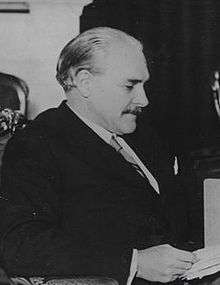Miklós Kállay
| Noble Dr. Miklós Kállay de Nagykálló | |
|---|---|
 | |
| Prime Minister of the Kingdom of Hungary | |
|
In office 9 March 1942 – 22 March 1944 | |
| Monarch |
Miklós Horthy as Regent |
| Preceded by | László Bárdossy |
| Succeeded by | Döme Sztójay |
| Personal details | |
| Born |
23 January 1887 Nyíregyháza, Kingdom of Hungary, Austria-Hungary |
| Died |
14 January 1967 (aged 79) New York City, New York, United States |
| Nationality | Hungarian |
| Political party | Unity Party, Party of National Unity, Party of Hungarian Life |
| Profession | politician |
Dr. Miklós Kállay de Nagykálló (23 January 1887, Nyíregyháza – 14 January 1967, New York City) was a Hungarian politician who served as Prime Minister of Hungary during World War II, from 9 March 1942 to 22 March 1944.
Career
The Kállay family was old and influential amongst the local gentry of their region, and Miklós served as lord lieutenant (ispán) of his county from 1921 to 1929. He then moved on to national government, serving first as deputy under secretary of state for the Ministry of Trade (1929–31) and later as minister of agriculture (1932–35). He resigned in 1935 in protest over the right-wing policies of Prime Minister Gyula Gömbös. He kept out of politics for most of the next decade before Hungarian Regent Miklós Horthy asked him to form a government to reverse the pro-Nazi policies of László Bárdossy in March 1942.
Although Hungary remained allied with Nazi Germany, Kállay and Horthy were conservatives who were unsympathetic to fascism, and Kállay's government refused to participate in the rounding up of Jews and other activities desired by the Nazis. The government also allowed the left-wing opposition (except for the Communists) to function without much interference. In foreign affairs, Kállay supported the German war effort against the Soviet Union. However, he made numerous peaceful overtures to the Western Allies, even going as far as to promise to surrender to them unconditionally once they reached Hungary's borders. The Germans finally had enough of their ally's policies and occupied Hungary in March 1944, forcing Horthy to oust Kállay and replace him with the more pliable Döme Sztójay.
Kállay was able to evade the Nazis at first, but he was eventually captured and sent first to the Dachau concentration camp and later to Mauthausen. In late April 1945 he was transferred to Tyrol together with other prominent concentration camp inmates, where the SS left the prisoners behind. He was liberated by the Fifth U.S. Army on 5 May 1945.[1]
In 1946 he went into exile, finally settling in the United States in 1951. In 1954, he published his memoirs, Hungarian Premier: A Personal Account of a Nation's Struggle in the Second World War.
References
Sources
- Antal Ullein-Reviczky, Guerre Allemande, Paix Russe: Le Drame Hongrois. Neuchatel: Editions de la Baconniere, 1947.
- Nicholas Kállay, Hungarian premier: a personal account of a nation's struggle in the second world war; forew. by C. A. Macartney, New York : Columbia Univ. P., 1954.
- C A Macartney, October Fifteenth: A History of Modern Hungary, 1929–1945, 2 vols, Edinburgh University Press 1956-7.
- György Ránki, Unternehmen Margarethe: Die deutsche Besetzung Ungarns, Böhlau, 1984.
- Ignac Romsics, Hungary in the Twentieth Century, Budapest: Corvina, 1999.
Antal Ullein-Reviczky, " German War, Russian Peace: The Hungarian Tragedy". Translated by Lovice Mária Ullein-Reviczky. Reno,NV. Helena History Press, 2014.
| Political offices | ||
|---|---|---|
| Preceded by Emil Purgly |
Minister of Agriculture 1932–1935 |
Succeeded by Kálmán Darányi |
| Preceded by Ferenc Keresztes-Fischer Acting |
Prime Minister of Hungary 1942–1944 |
Succeeded by Döme Sztójay |
| Minister of Foreign Affairs 1942–1943 |
Succeeded by Jenő Ghyczy | |